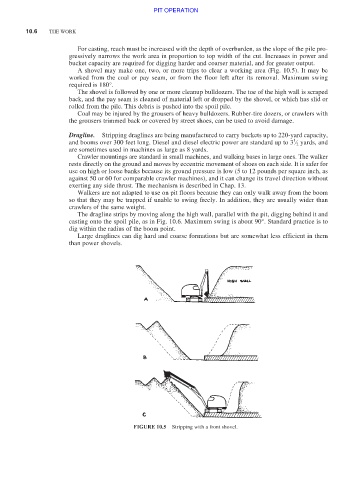Page 500 - Moving the Earth_ The Workbook of Excavation
P. 500
PIT OPERATION
10.6 THE WORK
For casting, reach must be increased with the depth of overburden, as the slope of the pile pro-
gressively narrows the work area in proportion to top width of the cut. Increases in power and
bucket capacity are required for digging harder and coarser material, and for greater output.
A shovel may make one, two, or more trips to clear a working area (Fig. 10.5). It may be
worked from the coal or pay seam, or from the floor left after its removal. Maximum swing
required is 180°.
The shovel is followed by one or more cleanup bulldozers. The toe of the high wall is scraped
back, and the pay seam is cleaned of material left or dropped by the shovel, or which has slid or
rolled from the pile. This debris is pushed into the spoil pile.
Coal may be injured by the grousers of heavy bulldozers. Rubber-tire dozers, or crawlers with
the grousers trimmed back or covered by street shoes, can be used to avoid damage.
Dragline. Stripping draglines are being manufactured to carry buckets up to 220-yard capacity,
1
and booms over 300 feet long. Diesel and diesel electric power are standard up to 3 ⁄ 2 yards, and
are sometimes used in machines as large as 8 yards.
Crawler mountings are standard in small machines, and walking bases in large ones. The walker
rests directly on the ground and moves by eccentric movement of shoes on each side. It is safer for
use on high or loose banks because its ground pressure is low (5 to 12 pounds per square inch, as
against 50 or 60 for comparable crawler machines), and it can change its travel direction without
exerting any side thrust. The mechanism is described in Chap. 13.
Walkers are not adapted to use on pit floors because they can only walk away from the boom
so that they may be trapped if unable to swing freely. In addition, they are usually wider than
crawlers of the same weight.
The dragline strips by moving along the high wall, parallel with the pit, digging behind it and
casting onto the spoil pile, as in Fig. 10.6. Maximum swing is about 90°. Standard practice is to
dig within the radius of the boom point.
Large draglines can dig hard and coarse formations but are somewhat less efficient in them
than power shovels.
FIGURE 10.5 Stripping with a front shovel.

